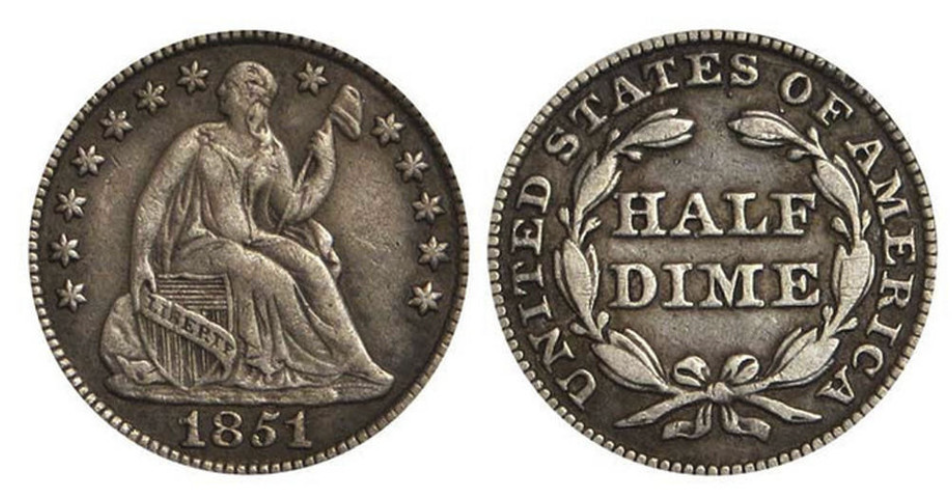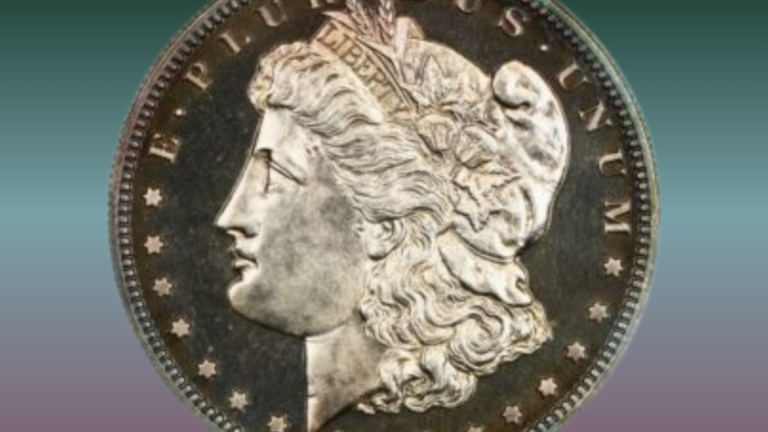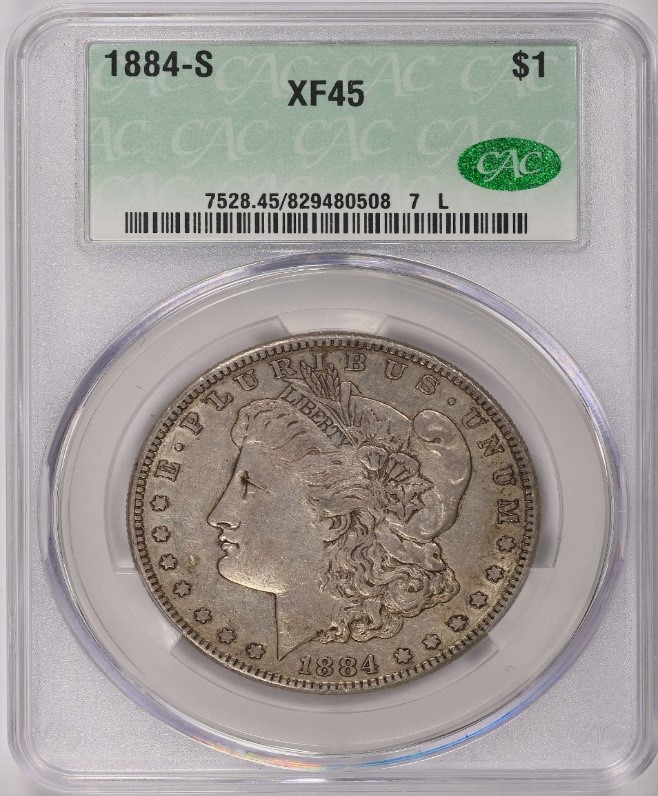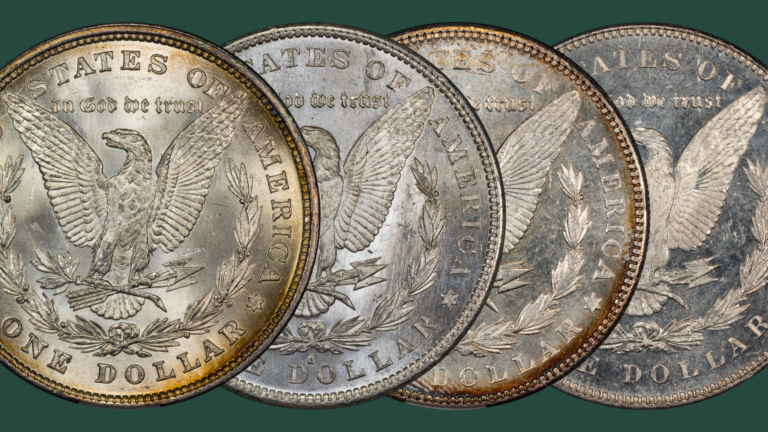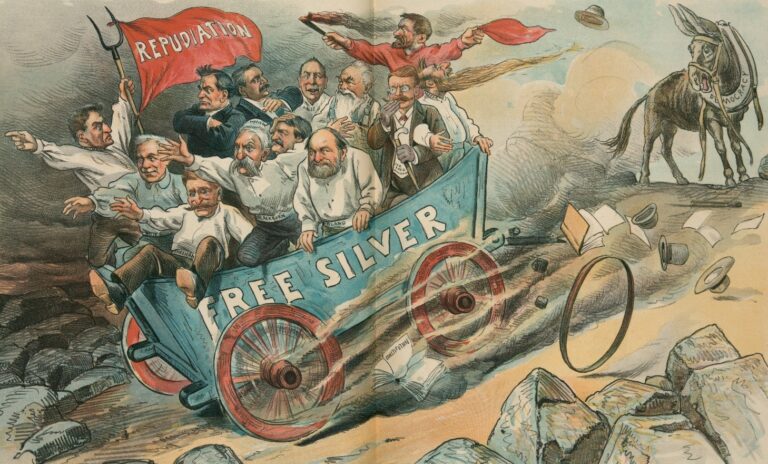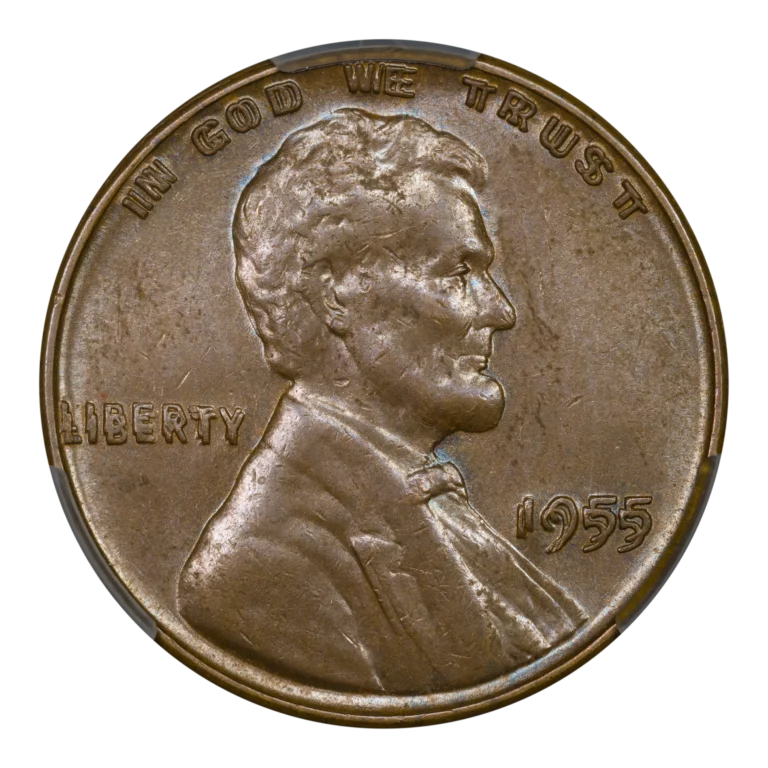by Greg Reynolds

Liberty Seated half dimes were minted from 1837 to 1873. Other than the 1870-S, of which only one is known, a complete set is not particularly difficult to assemble and would be enormously satisfying.
Collectors who are not interested in collecting these ‘by date’ or who are unsure as to whether to embark upon such a quest may wish to assemble a set ‘by type.’ Please click to read about collecting circulated half dimes or gem quality half dimes ‘by type.’ Collectors who like Liberty Seated half dimes, though, will find that collecting them ‘by date’ is easy enough and is fun.
Half Dime Type #5 – Liberty Seated, No Stars (1837-38)
Both Capped Bust half dimes and Liberty Seated dimes were minted during 1837. There are just three dates of this first Liberty Seated type.
The numerals in the year ‘1837’ vary such that the difference between the ‘Small Date’ and the ‘Large Date’ is substantial and readily noticeable without magnification. These are thus two different dates of the same year and design type. The 1837 ‘Small Date’ and the 1837 ‘Large Date’ each retail for less than $100 each in Fine-12 grade, the 1838-O for less than $400.
On May 24, 2020, the firm of David Lawrence sold a CAC approved, NGC graded AU-58 1837 ‘Large Date’ Liberty Seated half dime for $500. On March 8, 2020, GreatCollections sold a CAC approved, PCGS graded AU-55 1837 ‘Large Date’ for $468.
The 1837 ‘Small Date’ is a little scarcer and tends to be costlier than the 1837 ‘Large Date.’ In January 2020, Heritage sold a CAC approved, PCGS graded XF-45 1837 ‘Small Date’ for $363.60, a fair retail price.
The 1838-O is the scarcest of the three dates of this type. Indeed, it is rare in all grades.
A Good to VG grade 1838-O would probably cost between $100 and $250. On February 12, 2020, Heritage sold a CAC approved Fine-15 grade 1838-O for $504. On June 24, 2018, GreatCollections sold a CAC approved XF-40 grade 1838-O for $2327.62.
Half Dime Type #6: Liberty Seated, With Stars, No Drapery (1838-40)
On 1838 ‘With Stars’ issues, the size of the stars varies due to the nuances of die making and preparation procedures. Differences in the size of the stars are not indicative of different designs and are not particularly noticeable. All Philadelphia Mint 1838 half dimes are of the same date.
Unless a collector is seeking representatives of die pairings and die states, just one 1838 is needed for a set. It is thus efficient to select one that is labeled as having “Large Stars,” as these tend to be less costly than those labeled as having “Small Stars.”
As of December 15, 2020, a Good grade 1838 could be purchased for less than $10 and a Very Fine grade 1838 for less than $50. On June 24, 2018, GreatCollections sold a CAC approved AU-55 grade 1838 half dime for $194.06. This was a wholesale price, in my view. A retail price would then have been around $245.
A raw 1839 that grades in the range of Good-04 to Fine-12 could be obtained for less than $30. On May 24, 2020, the firm of David Lawrence sold a CAC approved AU-58 grade 1839 for $350.
The 1839-O is a rare coin, possibly undervalued from a logical perspective. In November 2020, price guides suggest that Good to VG grade 1839-O half dimes retail for less than $30 each.
In February 2018, David Lawrence sold a CAC approved, PCGS graded VF-25 1839-O half dime for $90. In May 2018, Heritage sold a CAC approved, PCGS graded AU-55 1839-O for $528.

With Drapery vs No Drapery Half Dimes
In the discussion about collecting half dimes ‘by type,’ I explain that the distinction between type #6, With Stars – No Drapery, and #7, With Drapery, amounts to far more than the addition of clothing material, “Drapery,” under an arm of the female personification of liberty. An 1840 ‘No Drapery’ dime and an 1840 ‘With Drapery’ dime are coins of noticeably different designs, with different artistry.
Even though the population numbers reported by PCGS, NGC and CAC are notably low, I maintain that there are dozens, probably more than one hundred, raw 1840 ‘No Drapery’ half dimes around. In regard to many dates in the series of Liberty Seated half dimes, there are a substantial number of AG-03 to Fine-12 grade coins that have never been submitted to PCGS or NGC.
If a dealer pays $15 for a raw coin with the idea of retailing it for $30 or wholesaling it for $20, it would not be cost-effective for him to submit it to PCGS or NGC. Even if a dealer paid just $5 for such a coin, a submission probably would still not be cost-effective.
On July 28, 2019, the firm of David Lawrence sold a PCGS graded Fine-12 1840, without a CAC sticker, for $39. In theory, there are or could be many certified dimes of this type that cost less than $100 each.
In grades from VF-35 to AU-55, CAC has approved twenty-one 1840 ‘No Drapery half dimes. The 1840-O is a different matter, as it is a truly rare coin in all grades. The combined PCGS and NGC population is 166, as of November 14, 2020. I estimate that this total amounts to around one hundred and five different coins, only fourteen of which are CAC approved. There could very well be be another hundred coins that have not been certified with numerical grades, many of which have never been submitted to PCGS or NGC. The overall total of surviving 1840-O ‘No Drapery’ half dimes is very likely to be less than 220.
On October 30, 2018, Stack’s-Bowers sold a PCGS graded VF-20 1840-O, without a CAC sticker, for $75. On December 7, 2019, Heritage auctioned a CAC approved AU-53 grade 1840-O ‘No Drapery’ half dime for $870.
Half Dime Type #7 – Liberty Seated, With Stars, With Drapery, No Arrows (1840-1859, except 1854-55)
There are quite a few relatively common dates of this design type, including 1841, 1843, 1845, 1849, 1850, 1852, 1856, 1857, 1858 and 1859. As of December 15, 2020, the CPG-CAC retail price estimates for common dates were $34 in VF-20, $46 in VF-30 grade, $81 in XF-40, $143 in AU-50 and $156 to $182 in AU-55 grade.
Mildly ‘better dates’ include 1842, 1848 ‘Medium Date, 1851-O and 1857-O. For this type, Philadelphia Mint dates tend to be much more common than New Orleans Mint dates. Curiously, half dimes were not struck at the San Francisco Mint until 1863. In contrast, dimes were first minted in San Francisco in 1856 and quarters in 1855. US. gold coins were struck there in 1854!
A collector may wish to collect just Philadelphia Mint dates while learning about half dimes. I suggest, however, a truly complete set of all Philadelphia, New Orleans and San Francisco mint dates before the ‘Legend on Obverse’ type (#8) was introduced in 1860. Such a set, of coins dating from 1837 to 1859, is likely to be surprisingly easy to assemble.
Values of Common Date vs Rare Date Liberty Seated Half Dimes
While this discussion covers three design types of Liberty Seated half dimes, it is not practical to discuss every date here. Half dimes of most of the dates not mentioned are inexpensive.
Budget-minded collectors tend to be concerned about the costs of rare dates. The 1844-O is a semi-key and is a truly rare coin. On November 4, 2018, GreatCollections sold a PCGS graded Good-04 1844-O for $73.12. On January 9, 2017, Heritage sold a CAC approved, PCGS graded VF-25 1844-O for $998.75.
In terms of market values, the 1846 is the key date, though less expensive dates in the series may be in the same category of rarity. It is plausible that there are more than two hundred 1846 half dimes in existence.
In an article of mine that was published online on July 13, 2016, I reported that PCGS had graded 101 1846 half dimes. As of November 14, 2020, this total has increased to 125. During the same time span, the NGC total increased from 58 to 67. I doubt that more than a couple of never-before submitted coins, if any, are included in the population increases. Some of the same coins are submitted on multiple occasions.
In 2016, I theorized that less than 125 different 1846 half dimes have received numerical grades from PCGS or NGC, and this remains a tenable estimate. Additionally, there are probably twenty to thirty-five in PCGS or NGC ‘Details’ holders. If there remain another twenty to thirty-five that are not in PCGS or NGC holders, then 150 to 195 1846 half dimes survive. It is a realistic possibility that a collector could find an ungradable 1846 half dime in a PCGS or NGC ‘Details’ holder for less than $600.
On October 14, 2018, the firm of David Lawrence sold a CAC approved, PCGS graded Good-06 1846 for $1050. On December 6, 2019, Heritage auctioned a CAC approved, PCGS graded Fine-12 1846 for $1740. On August 5, 2018, GreatCollections sold a CAC approved, NGC graded XF-45 1846 half dime for $3940.88.
The 1849 ‘regular date’ is a common date. There definitely exists an 1849/6 overdate. There has been disagreement among researchers as to whether there also exist 1849/8 overdate half dimes. Separate research by Tom DeLorey and Clint Cummins has contributed to the body of knowledge about these. Until recently, the majority view among researchers was that the 1849 ‘regular date,’ the 1849/6 and the 1849/8 are three different dates.

Show off Your Collection in the CAC Registry!
Have CAC coins of your own? If so, check out the CAC Registry–the free online platform to track your coin inventory, showcase your coins by building public sets, and compete with like-minded collectors!
Liberty Seated Half Dimes with Overdates
The current view is that there are notable varieties of 1849/6 overdates, and that there has never been an 1849/8 overdate half dime. The current view holds that the numeral ‘9’ was punched over a widely spaced ‘6’ on one die and on another die it was punched over a ‘6’ that was relatively close to the numeral ‘4.’ For a set ‘by date,’ any 1849/6 overdate is acceptable. The underlying truth, which is had to discern, is beside the point that the market values of both overdates have fallen because they are both now regarded as varieties of 1849/6 overdate half dimes rather than being separate overdates.
A raw 1849/6 could be acquired for less than $50, much less in some instances. Only about a dozen circulated representatives of this overdate have been CAC approved, and one has not publicly sold recently.
On October 29, 2019, Heritage sold a PCGS graded XF-40 1849/6, without a CAC sticker, for $168. On December 31, 2019, Heritage sold a PCGS graded VF-25 1849/6, without a CAC sticker, for $180, more than the just mentioned coin with a higher PCGS grade. The overdate aspect on the PCGS graded VF-25 coin, however, is very much apparent.
On March 3, 2019, GreatCollections sold a PCGS graded XF-45 1849/6, without a CAC sticker, for $281.91. On August 11, 2019, the firm of David Lawrence sold a PCGS graded AU-55 1849/6, without a CAC sticker, for $405. The extent to which the overdate is noticeable is a factor that contributes the value of an 1849/6. A coin with a rather apparent overdate without magnification is usually worth more than a coin of equivalent quality that requires a close inspection with a magnifier just to detect a trace of an overdate.
The differences between the two current classifications of 1849/6 half dimes must be scrutinized with high magnification to be properly interpreted, and there will never be close to unanimous agreement regarding the finer points. For a set ‘by date,’ however collectors now need just two half dimes from the year 1849, rather than needing three in the past while the 1849/8 was still recognized.
The 1849-O is a better date, though is not rare. On June 24, 2018, GreatCollections sold a CAC approved VG-10 1849-O half dime for $97.99. On December 6, 2019, Heritage auctioned a CAC approved XF-45 1849-O for $1050.
The 1853-O ‘No Arrows’ Half Dime
The 1853-O ‘No Arrows’ is a rare coin, which could be fairly referred to as a semi-key or even as a key date. All half dimes, dimes, quarters and half dollars were required to have ‘arrows’ as parts of their respective obverse designs by June 1, 1853. In response to my inquiries, however, leading researcher R. W. Julian explained that design modifications and the production of prepared blanks (planchets) in accordance with the new standard probably began as soon as it was practical to implement the Mint Act of 1853, which was passed in February. For a short time, 1853 and 1853-O ‘No Arrows’ half dimes were minted.
The addition of arrows indicated a slight, though consequential, reduction in the silver content and total weight of half dimes, dimes, quarters and half dollars, respectively. Silver coins of 1853 are addressed at length in two articles that I wrote in 2014, which are still available online.
The estimate of “112” known 1853 ‘No Arrows’ half dimes on the PCGS CoinFacts site is low, in my view. PCGS has graded ninety-one and NGC has graded thirty-four, for a total of 125, which probably amounts to less than one hundred different coins. There are at least another thirty around, including those that are clearly ungradable. I theorize that 120 to 145 1853-O ‘No Arrows’ half dimes survive.
On March 3, 2020, Heritage sold a PCGS graded Good-04 1853-O ‘No Arrows’ half dime without a CAC sticker for $336. On November 3, 2020, Heritage sold a PCGS graded VG-08 1853-O ‘No Arrows’ half dime without a CAC sticker for $480. On January 26, 2020, GreatCollections sold a PCGS graded VF-30 1853-O ‘No Arrows,’ also without a CAC sticker, for $1698.75.
The Assembly of a Liberty Seated Half Dime Set
In regard to 1837 to 1853 Liberty Seated half dimes, before arrows were added to the design in 1853, a complete set ‘by date’ in circulated grades is practical though not really easy to assemble. Within a few years, decent representatives of all the dates may be acquired without spending a large amount of money on any one of them.
Although a CAC-only set of circulated half dimes would be more pleasant and more satisfying than a set with many non-CAC coins, a CAC-only set might take much longer to assemble as CAC has approved just a small number of circulated coins of some dates in the series of Liberty Seated half dimes. While seeking scarce coins, patience is often beneficial anyway. I would prefer to wait a year or more for a coin that I like than to acquire a ‘low end’ or annoying coin of the same date right away.
Copyright © 2021 Greg Reynolds
About the Author
Greg is a professional numismatist and researcher, having written more than 775 articles published in ten different publications relating to coins, patterns, and medals. He has won awards for analyses, interpretation of rarity, historical research, and critiques. In 2002 and again in 2023, Reynolds was the sole winner of the Numismatic Literary Guild (NLG) award for “Best All-Around Portfolio”.
Greg has carefully examined thousands of truly rare and conditionally rare classic U.S. coins, including a majority of the most famous rarities. He is also an expert in British coins. He is available for private consultations.
Email: Insightful10@gmail.com
